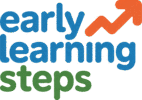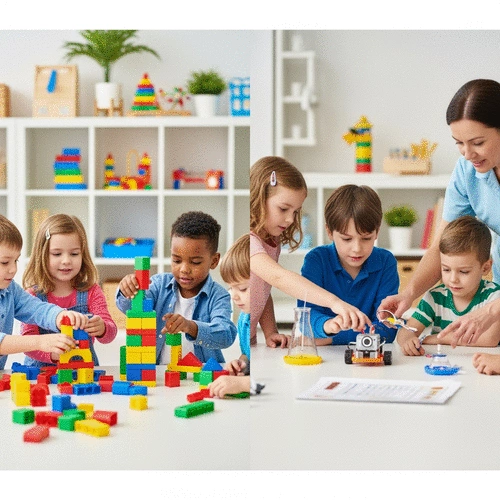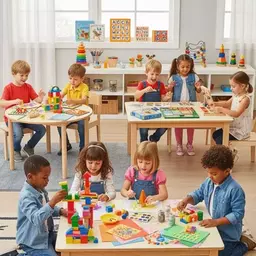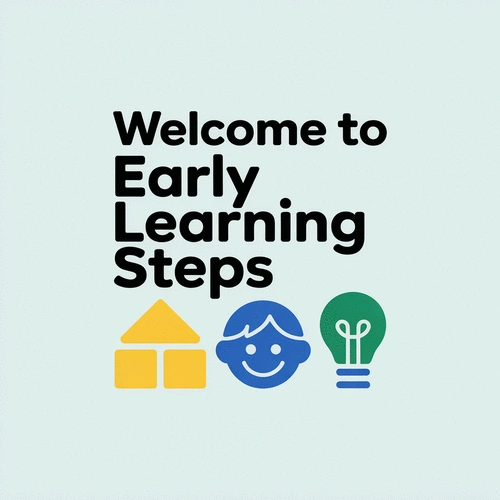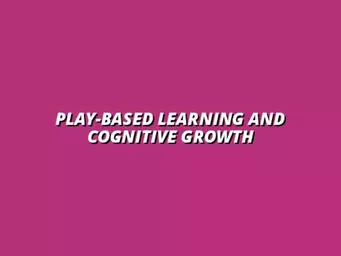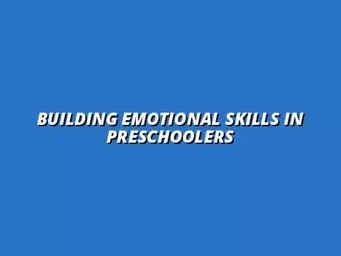What if the key to unlocking a child’s potential lies not just in structured lessons but in the freedom to explore? The debate between play-based and STEM curricula in early education is more than just a choice; it’s about shaping the future of our children. Let’s delve into the essential insights that can guide you in making the best curriculum decisions for young learners.
What You Will Learn
- Play-based curriculum enhances creativity, problem-solving, and social skills through exploration and hands-on activities.
- STEM curriculum promotes logical reasoning and technical skills, preparing children for future academic and professional success.
- A balanced approach that integrates both play-based and STEM elements can provide a comprehensive learning experience for children.
- Creating engaging learning environments involves incorporating natural elements, setting up learning stations, and allowing flexible spaces for play and reflection.
- Utilizing developmentally appropriate practices fosters independence and exploration, ensuring that activities align with children's developmental stages.
Curriculum Comparison: Play-Based vs. STEM
This visual highlights the core differences and benefits of Play-Based and STEM curricula in early childhood education.
Play-Based Curriculum
Emphasizes exploration, imagination, and learning through active engagement.
- ✓ Promotes curiosity & creativity
- ✓ Problem-solving (real-world)
- ✓ Fosters independence
STEM Curriculum
Integrates Science, Technology, Engineering, and Math into structured experiences.
- ✓ Encourages logical reasoning
- ✓ Promotes teamwork & collaboration
- ✓ Real-world applications
Balanced Approach: The Best of Both Worlds
Integrating both curricula provides a comprehensive learning experience.
Fosters creativity, critical thinking, and prepares children for future academic success.
Understanding the Differences: Play-Based vs. STEM Curriculum
When it comes to early childhood education, the choice between a play-based curriculum and a STEM curriculum can feel overwhelming. Each approach offers unique benefits that can shape a child's learning experience. At Early Learning Steps, we believe that understanding these differences is key to fostering an environment where children can thrive creatively and intellectually.
Let’s explore what each curriculum entails, starting with the heart of play-based learning. This method prioritizes exploration, allowing children to learn through their natural instincts and interests! This approach significantly contributes to play-based learning and cognitive growth, enhancing their developmental journey.

Defining Play-Based Curriculum: The Role of Exploration in Learning
A play-based curriculum emphasizes the role of exploration and imagination in a child's learning journey. It is built on the idea that children learn best when they are actively engaged in play. This approach encourages children to investigate their surroundings, ask questions, and make discoveries through hands-on activities.
- Promotes curiosity and creativity
- Encourages problem-solving through real-world scenarios
- Fosters independence and confidence
By engaging in play, children develop critical thinking skills as they encounter challenges and devise their own solutions. The beauty of this curriculum lies in its flexibility, allowing educators to tailor activities to meet children's unique interests.
Unpacking STEM Curriculum: Integrating Science, Technology, Engineering, and Math
On the other hand, a STEM curriculum focuses on integrating science, technology, engineering, and math into learning experiences. This approach not only prepares children for future academic success but also equips them with vital skills needed in today's world. By focusing on practical applications, a STEM curriculum can also help in building emotional skills in preschoolers, as collaborative projects often require strong communication and empathy.
- Encourages logical reasoning and analytical skills
- Promotes teamwork and collaboration through projects
- Provides exposure to real-world applications of STEM concepts
STEM activities often involve structured experiments and technology-based projects that challenge children’s minds. These experiences prepare children for a rapidly evolving future by instilling a love for inquiry and discovery.
Interactive Poll: Your Thoughts on Curriculum Choice
As we explore the differences between play-based and STEM curricula, we want to hear from you! Which approach do you believe is more beneficial for early childhood education?
Summarizing Key Insights for Educators and Parents
As we dive deeper into the world of early childhood education, it becomes vital to grasp how our curriculum choices shape the future of our children. At Early Learning Steps, we are committed to helping parents and educators understand the long-term outcomes of play-based versus STEM curricula. Both approaches hold unique benefits, and recognizing these can guide us in nurturing well-rounded, confident learners.
To summarize the key insights for educators and parents, let’s focus on three main areas: the long-term impact of curriculum choices, how to create engaging learning environments, and the importance of developmentally appropriate practices.

Long-Term Outcomes: Understanding the Impact of Curriculum Choices
Choosing the right curriculum for early learners can significantly influence their academic journey. Research suggests that play-based learning fosters creativity and emotional intelligence, while a robust STEM curriculum equips children with essential skills for future academic success.
- Play-Based Curriculum: Enhances creativity, problem-solving, and social skills.
- STEM Curriculum: Promotes logical thinking, technical skills, and innovation.
- Balanced Approach: Integrating both can provide a comprehensive learning experience.
Understanding these outcomes helps educators and parents make informed choices that best align with their children's needs and interests.
Creating an Engaging Learning Environment: Practical Tips for Integration
At Early Learning Steps, I’ve always believed that the learning environment plays a crucial role in child development. Here are some practical tips for creating an engaging atmosphere that blends both play and structured learning:
- Incorporate natural elements: Use materials like sand, water, and leaves to stimulate exploration.
- Set up learning stations: Create zones for different activities to encourage choice and autonomy.
- Utilize flexible spaces: Allow for both quiet reflection and energetic play to cater to various learning styles.
When children feel safe and inspired in their learning environments, they are more likely to engage deeply with the curriculum. This also aligns with principles of integrating UDL in early childhood, ensuring that diverse learners can access and engage with the material effectively.
Utilizing Developmentally Appropriate Practices in Educational Settings
Implementing developmentally appropriate practices is essential for supporting young learners effectively. This means tailoring activities to meet children where they are in their developmental journey. In my experience, utilizing a mix of guided and free play, particularly in early learning centers, allows children to thrive.
- Encourage exploration: Allow children to investigate their interests freely.
- Provide scaffolding: Offer support when necessary, but encourage independence.
- Incorporate family input: Engage families in discussions about their child's learning preferences and home experiences.
By prioritizing developmentally appropriate practices, we can create a supportive and enriching environment that nurtures every child’s potential.
Frequently Asked Questions (FAQs)
What is the main difference between a play-based and a STEM curriculum?
A play-based curriculum focuses on exploration, imagination, and learning through active engagement, fostering creativity and emotional intelligence. A STEM curriculum integrates science, technology, engineering, and math into structured experiences, promoting logical reasoning and technical skills.
What are the key benefits of a play-based curriculum?
Play-based curricula promote curiosity, creativity, problem-solving through real-world scenarios, and foster independence and confidence in children.
How does a STEM curriculum prepare children for the future?
A STEM curriculum encourages logical reasoning and analytical skills, promotes teamwork and collaboration, and provides exposure to real-world applications of STEM concepts, equipping children with vital skills for future academic and professional success.
Can play-based and STEM curricula be integrated?
Yes, integrating both curricula offers a balanced approach that provides a comprehensive learning experience, fostering creativity, critical thinking, and preparing children for future academic success by combining the best of both worlds.
What are some practical tips for creating an engaging learning environment?
Practical tips include incorporating natural elements, setting up various learning stations to encourage choice, and utilizing flexible spaces that allow for both quiet reflection and energetic play, catering to diverse learning styles.
Recap of Key Points
Here is a quick recap of the important points discussed in the article:
- Play-Based Curriculum: Enhances creativity, problem-solving, and social skills through exploration and imagination.
- STEM Curriculum: Promotes logical thinking, technical skills, and innovation, preparing children for future academic success.
- Balanced Approach: Integrating both play-based and STEM curricula can provide a comprehensive learning experience that nurtures well-rounded learners.
- Creating engaging learning environments involves incorporating natural elements, setting up learning stations, and utilizing flexible spaces.
- Implementing developmentally appropriate practices is essential to support young learners effectively and encourage their exploration and independence.
